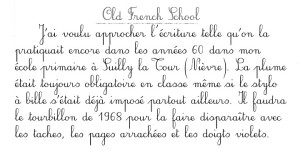My concern for all kids is whether or not they are developing a “flow” in their thinking and expression of their thoughts. Personally, I think there is a pervasive shift in the way we are communicating (a lot more oral communication and visual communication, and a lot less written). Are schools stuck in the old ways? But… how are we going to communicate / transmit ideas without being fluent written communicators? I don’t see how we can have logical arguments without being able to point to specific ideas or thoughts — it’s hard to know exactly what someone said or thought without the written word to point to.
Writing to me is part of the process of developing logical thinking. Yet I see many, many kids struggle with this. It starts with learning how to print letters, and becomes noticeably difficult when cursive is introduced. (Somehow they start kids off with cursive in France… interesting!)

When you see a child struggling to remember how to form a letter, and then how to join letters together, you see there is no more “cognitive space” to think about expressing one’s own ideas. It’s more like seeing someone learn how to roll modeling clay to make a skinny tube than to create a unique sculpture. Yes, we all need to be patient and allow the child to develop the skill… yet are the students given adequate time to learn this difficult skill?
 Which, of course, brings me to baseball.
Which, of course, brings me to baseball.
If you have ever played baseball, you may discover that there are so many individual sub-skills that you need to develop that it can be difficult to perform on the spot. If a ball is hit your way, you have to process so many things at the same time: run toward the ball, estimate when it will come nearest to you, rotate your glove in the best way to receive it, judge the speed and the height the ball will come at you based on where it bounces, etc. Just knowing which way to rotate your wrist is a major skill. Oh, yeah, then you need to catch it — or chase it.
The point, obviously, is that you need to train yourself, for hours on end, to make certain skills automatic.
When writing, you need to be able to hold a complete thought in working memory. You need to be able to hang onto it long enough to write every word of that thought down. Perhaps it’s like a phrase in music; it makes sense only when it’s complete.
Most students I work with cannot do both. They cannot think about how to connect the letter o to the letter u in cursive and write a narrative about what they think of a character in a story. They need to dictate their ideas, which are generally disorganized or simply responses to direct questions, and then they can think about what they said. It’s messy and very dissatisfying… and they never know if the teacher will accept what they’ve said or written. They are often insecure about the expression of their ideas.
Girls tend to be more interested in the appearance of their writing. Yes, we’ve all seen the hearts and flowers which dot i’s and j’s. Girls tend to be more patient in learning the formation of the letters, and spend time outside of school trying out different ways to form letters and words with their pencils and pens.
Which, of course, brings me to female teachers.
Most elementary teachers are women. (There’s a nice article here about this: https://abcnews.go.com/Health/men-teach-elementary-school/story?id=18784172.) According to MenTeach.com, only 18% of elementary teachers are men. My experience is that female teachers expect that their students spend free time practicing cursive because… it is fun. Similarly, women tend to enjoy going to stationery stores and buying nice notebooks and pens because they are pretty and pleasing and of course they want to fill them up with notes. Here is an obvious gender divide, and I see many boys fall off the cliff. They struggle with the act of writing; they do not develop a flow in their thoughts which can be transcribed through their hands; and they are penalized as being “sloppy” and “lazy” for their poor output.
While most parents have encountered this problem, what do we propose to do about it? Should we simply declare cursive and printing a lost art and get all kids onto keyboards? But… do they develop the “flow” of their thoughts any better on the keyboard? (And btw most keyboarding skills are very poor, and do not improve much when introduced too young. In my experience, 6th grade is the first time kids can actually flow with their thoughts and their keyboards simultaneously.)
My suggestions are (1) allow more time DAILY in the classroom for good ol’ practice, starting in 3rd grade. Not forcing the kids to come up with original thoughts, but just practice, boring practice, 30 minutes a day. (2) Allow extra time for kids with ADHD and executive skills deficits on all written assignments. (3) Discuss and describe the flow of thoughts with your child. How do you transfer the ideas that you have in your head to others? Especially if you are in a profession where written words are judged and pointed to — science, law, broadcast journalism. (4) Spend more time with kids on the sequences of good writing — and help them understand how the audience processes information — not all at once, but note by note, sentence by sentence.
Finally, we need to remind ourselves that for most people, writing is hard. For good writers, writing is hard. Wrestling with conflicting ideas is hard; spending a long time with a pen and paper is wearying. Kids can learn the rewards of expressing their ideas in other ways, too, through videos and art and so on. Still, we need to be able to write! We need to buckle down and do more of it, both the skill and the art.